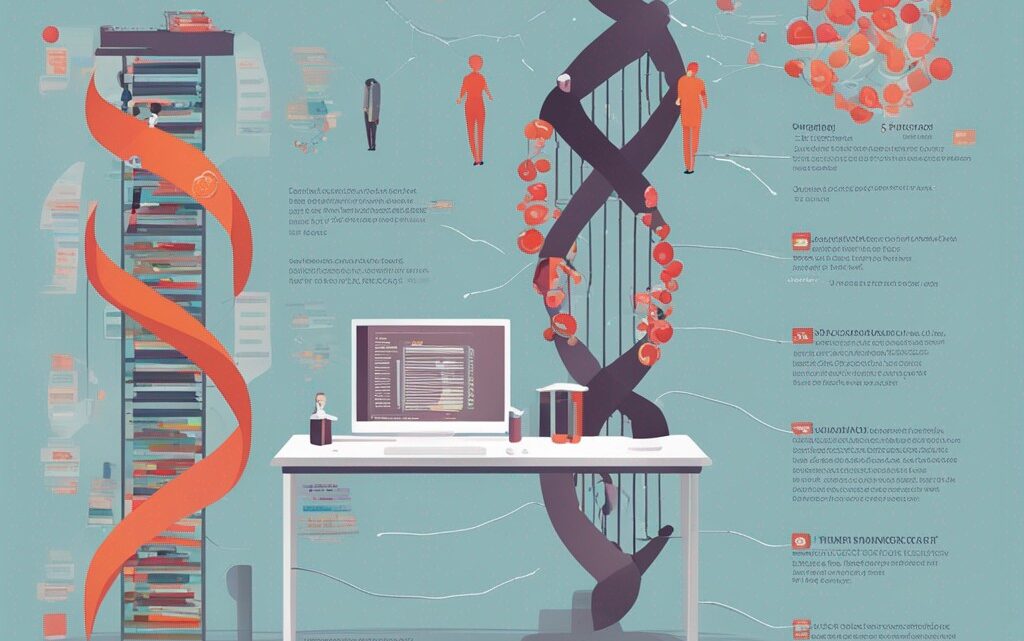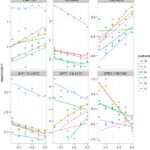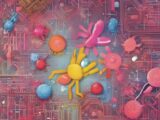
RNA-seq Data Analysis: Ultimate Guide from Sample preparation to RAM Requirements
September 6, 2023Unlocking the Power of RNA-seq: Essential Guide to System Requirements
You know how we’ve always been fascinated by the idea of understanding the building blocks of life? Well, that’s where RNA-Seq steps in, turning our dreams into reality. It’s a tool we use for a kind of deep dive into a realm known as the transcriptome, which is just a fancy way of talking about all the RNA in our cells at any given moment. Now, why is this such a big deal? Let’s delve into it.
What’s the Point of Using RNA-seq?
RNA-Seq isn’t just for show; it’s a game-changer for scientists. With it, we get to know everything from how genes splice differently to how they act under various conditions—like in sickness or health, or when you’re exposed to different environments. This is invaluable when we’re trying to figure out new ways to tackle diseases or understand human biology.
What is the difference between RNA-seq and RT PCR?
RNA-seq and RT-PCR (Reverse Transcription Polymerase Chain Reaction) are both methods used for analyzing gene expression but differ in several ways:
Sensitivity: RNA-seq is generally more sensitive and can detect more genes, including novel ones. RT-PCR usually focuses on known targets.
Quantification: RT-PCR is considered more accurate for quantifying the expression levels of a limited number of genes. RNA-seq provides a broad view of the transcriptome but may require additional steps for precise quantification.
Scale: RNA-seq provides a high-throughput method to examine the whole transcriptome, whereas RT-PCR usually examines one or a few genes at a time.
Cost: RT-PCR is generally less expensive for analyzing a few genes, whereas RNA-seq is more cost-effective for whole transcriptome studies.
Is RNA-Seq the same as NGS?
RNA-Seq is a type of Next-Generation Sequencing (NGS). NGS is a general term that refers to high-throughput sequencing technologies, of which RNA-Seq is a specific application focused on sequencing RNA transcripts.
Why is RNA-Seq better?
RNA-Seq has several advantages, including a broader range of detectable gene expression changes, the ability to identify novel transcripts, and the ability to perform more comprehensive analyses like alternative splicing.
Is RNA sequencing better than DNA sequencing?
They serve different purposes. RNA sequencing informs about gene expression and transcriptome profiles at a given time, whereas DNA sequencing provides more static information about the genetic blueprint. “Better” depends on what you aim to study.
Why do we sequence RNA instead of DNA?
Sequencing RNA provides a dynamic view of a cell’s function over time, allowing researchers to understand gene expression patterns. DNA is static and does not offer insights into which genes are actively being translated into proteins.
What are the advantages of RNA sequencing over DNA?
RNA sequencing can offer a real-time snapshot of cellular activity, detect alternative splicing, identify novel transcripts, and provide quantitative gene expression levels.
Why use RNA instead of DNA in PCR?
Using RNA in PCR (RT-PCR) allows for the study of gene expression levels, which is not possible if only DNA is used.
What are the disadvantages of RNA sequencing?
Some disadvantages include high cost, complexity in data analysis, and difficulty in detecting low-abundance transcripts. RNA is also more unstable than DNA, making sample preparation more challenging.
What are the disadvantages of RNA over DNA?
Compared to DNA, RNA typically exists in lower quantities and is more unstable.
What is the most important difference between DNA and RNA?
The most important functional difference is that DNA stores genetic information, while RNA acts to carry out this information through protein synthesis.
What are the 3 types of RNA?
The three primary types of RNA are mRNA (messenger RNA), rRNA (ribosomal RNA), and tRNA (transfer RNA).
Which RNA is the most important?
It’s challenging to say which is “most important,” as all play essential roles. However, mRNA is often the focus of studies of gene expression.
What are the 4 main differences between DNA and RNA?
1. Sugar: DNA contains deoxyribose, RNA contains ribose.
2. Bases: DNA uses adenine, cytosine, guanine, and thymine. RNA uses adenine, cytosine, guanine, and uracil.
3. Structure: DNA is double-stranded, RNA is usually single-stranded.
4. Function: DNA stores genetic info; RNA is more active in protein synthesis.
What are 3 ways DNA is different from RNA?
1. DNA is double-stranded; RNA is single-stranded.
2. DNA contains thymine; RNA contains uracil.
3. DNA is stable under alkaline conditions; RNA is not.
What is the functional difference between DNA and RNA?
DNA serves as the long-term storage of genetic information, whereas RNA serves as the template for protein synthesis.
What are 3 similarities between DNA and RNA?
1. Both are nucleic acids.
2. Both use adenine, guanine, and cytosine.
3. Both are vital for genetic and protein synthesis functions.
What can RNA do that DNA Cannot?
RNA can act as a catalyst, perform self-replication, and is involved in protein synthesis as a messenger, transfer agent, or as part of the ribosome.
What is the chemical difference between DNA and RNA?
DNA contains deoxyribose sugar, while RNA contains ribose sugar. DNA uses the base thymine, whereas RNA uses uracil.
Does RNA store genetic information?
Generally, RNA acts as a messenger carrying instructions from DNA, but certain viruses (like HIV) have RNA genomes, demonstrating that RNA can also store genetic information.
The Importance of Sample Preparation and Quality Assessment in RNA-seq: A Comprehensive Guide
RNA sequencing (RNA-seq) has become the go-to method for transcriptomic analysis, offering unparalleled insight into the expression levels of genes and their isoforms. However, the accuracy and utility of the data obtained are heavily dependent on the quality of sample preparation and RNA extraction. This essay aims to elucidate the critical steps, best practices, and quality assessment methods essential for successful RNA-seq experiments.
RNA-seq: A Superior Transcriptomics Method
Before diving into the intricacies of sample preparation, it is crucial to understand why RNA-seq has gained favor over other transcriptomics methods such as microarrays. RNA-seq offers several distinct advantages:
1. It does not require a priori knowledge of the genome sequence, providing an unbiased view of the transcriptome.
2. It has no upper quantification limits and can detect lowly expressed genes with high sensitivity.
3. It allows for the assessment of transcriptome dynamics across different conditions and tissues.
4. It is highly reproducible and can detect and quantify alternative splicing events, gene fusions, and single nucleotide variants.
Essential Steps in RNA Sample Preparation
RNA sample preparation for RNA-seq is a meticulous process that involves several stages. First, total RNA is isolated from the sample using column-based RNA purification kits such as Qiagen’s RNeasy kit. Once the RNA is isolated, it may be enriched for specific RNA types like mRNA or microRNA, depending on the study’s focus.
Ensuring the quality of the RNA sample is vital. Best practices suggest storing tissue samples from which RNA will be extracted at -80°C to preserve integrity. RNA stabilization reagents may also be employed for this purpose.
The amount of RNA needed for sequencing can vary, but it is typically between 100 ng to 1 µg. Before proceeding with library preparation, quality and quantity checks are imperative.
Assessing RNA Quality
The importance of RNA quality in RNA-seq experiments cannot be overstated. Various techniques are employed to assess RNA quality:
1. Spectrophotometry: Measures the RNA concentration and purity by evaluating the absorbance at 260 nm and 280 nm wavelengths.
2. Bioanalyzer: Provides an RNA Integrity Number (RIN), which is a reliable measure of RNA quality.
3. Gel Electrophoresis: Enables the visualization of RNA integrity.
4. Fluorometry: Another method to measure RNA concentration and purity.
5. qPCR-Based Assay: Used occasionally to validate RNA quality further.
The Impact of RNA Quality on Downstream Analysis
Inadequate RNA quality can severely impact the subsequent steps of RNA-seq and the validity of the study. RNA degradation can lead to a loss of information and introduce bias in the sequencing data. Contaminants like genomic DNA or proteins can hinder library preparation and sequencing, causing data quality issues. Therefore, multiple quality control steps are recommended before proceeding with library preparation and sequencing.
In conclusion, RNA-seq is a powerful tool for understanding the transcriptome, offering advantages like high sensitivity and the ability to study transcriptome dynamics. However, the success of an RNA-seq experiment is profoundly influenced by the care taken during sample preparation and quality assessment. Researchers must adhere to best practices for RNA extraction, storage, and quality control to ensure that the resulting data is both accurate and meaningful.
Limitations of RNA-seq
Despite its versatility and broad applications, RNA-seq is not without its limitations. Some of the primary challenges include:
1. High Cost and Time-Intensive Process: The entire procedure, from assay design to data analysis, is expensive and requires considerable time.
2. Technical Noise and Biological variation: These can compromise the quality of the data and make it challenging to interpret the results.
3. Low Capture Efficiency: In single-cell RNA-seq, the low amount of starting material can result in high dropout rates.
4. Transcript Coverage Bias: This issue is particularly prevalent in single-cell RNA-seq.
5. Computational Challenges: The sheer volume of data generated requires high computational power and specialized expertise for analysis.
6. Inefficiency for Known Markers: If the study is focused on a subset of known genes, RNA-seq may be overkill in terms of both cost and data generated.
7. Inability to Detect Low-Abundance Transcripts: In samples with high levels of ribosomal RNA, detecting low-abundance transcripts can be challenging.
Common RNA-seq Data Analysis Tools
There is a plethora of tools available for RNA-seq data analysis. Here are some of the more commonly used platforms:
1. GenePattern: An online, free-to-use platform that requires no programming knowledge.
2. GeneProf: Provides easy-to-use pipelines for RNA-seq and other sequencing methods.
3. GREIN: An interactive platform for re-analyzing GEO RNA-seq data.
4. S-MART: Handles mapped RNA-Seq data for various manipulation tasks.
5. Omics Playground and Rosalind: These are commercial software but offer user-friendly interfaces.
Open-Source RNA-seq Data Analysis Tools
For researchers who prefer open-source options, several platforms fit the bill:
1. BioWardrobe: An integrated package that includes various functionalities like mapping, quality control, and differential expression analysis.
2. GenePattern: While available online, it’s also open-source for those who wish to modify it.
3. GeneProf: Provides free pipelines for various sequence analysis tasks.
4. GREIN: Interactive and open-source, allowing for both new analyses and re-analyses of existing data sets.
5. S-MART: Available on GitHub, this tool handles various data manipulation tasks.
Installing and Using Open-Source RNA-seq Tools
Installing and using these tools can differ, but the general steps are:
1. Choose the tool.
2. Follow installation instructions from the tool’s documentation.
3. Familiarize yourself with its interface and functionalities.
4. Prepare your data as per the tool’s requirements.
5. Conduct your analysis.
6. Interpret the results.
System Requirements
System requirements can vary, but general considerations include:
Operating System: Usually Linux, though some tools support Windows and macOS.
Processor: A multi-core processor for efficient data processing.
RAM: At least 8 GB is recommended.
Storage: Adequate space for data storage.
Dependencies: Some tools require pre-installed software like Python or R.
Recommended RAM
Though 8 GB of RAM is usually the minimum recommended for running these tools, the actual amount can depend on the tool and the data’s complexity. Always consult the specific tool’s documentation for detailed system requirements.
RAM Requirements for RNA-seq Data Analysis: A Dynamic Landscape
The amount of Random Access Memory (RAM) required for RNA-seq data analysis can be significantly influenced by various factors, including the size of the dataset, the type of analysis being conducted, the complexity of the organism’s genome, and the specific software tools being used. Here’s how these variables generally influence the RAM requirements:
Dataset Size and Complexity
1. Genome Size: For STAR alignment, the RAM requirements are often at least 10 times the genome size in bytes, suggesting that larger genomes will necessitate more RAM.
2. Number of Reads: Standard RNA-seq experiments can range from 5 million to 200 million reads per sample. More reads generally mean more RAM will be needed for analysis.
3. Type of RNA-Seq: Different types of RNA-seq like miRNA-Seq or small RNA-Seq may require fewer reads and, consequently, less RAM.
Specific Analytical Goals
1. Gene Expression Profiling: Experiments focusing on highly expressed genes may need fewer reads (5–25 million reads per sample) and may be adequately conducted with 8 GB of RAM.
2. Cell Aggregation: Tools like cellranger aggr for single-cell RNA-seq may require at least 64GB RAM to aggregate up to 250k cells, and the requirements can scale up with more cells.
Software Requirements
1. TopHat2: This tool can run with as little as 8 GB of RAM and 4 cores on a cluster.
2. QIAGEN Digital Insights: This tool requires at least 16 GB of RAM, with 24 GB recommended for optimal performance.
Minimum RAM for Small Datasets
For small RNA-seq datasets, the minimum RAM requirements can differ based on the particular type of analysis and the complexity of the genome:
1. Basic Mammalian Genome Analysis: At least 30 GB of RAM is generally required.
2. Gene Expression Profiling: For simpler analyses focusing on highly expressed genes, 8 GB of RAM may suffice.
3. miRNA-Seq or Small RNA Analysis: These analyses might require even fewer reads and could potentially be conducted on a system with less than 8 GB of RAM.
4. QIAGEN Digital Insights: For data generated with QIAseq panels, at least 16 GB RAM is required.
Final Thoughts
It’s crucial to remember that these are general guidelines and actual requirements can vary. Always consult the documentation of the specific tool you are using for the most accurate system requirements and recommendations.


















